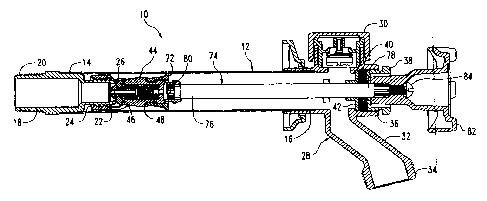Some of the information on this Web page has been provided by external sources. The Government of Canada is not responsible for the accuracy, reliability or currency of the information supplied by external sources. Users wishing to rely upon this information should consult directly with the source of the information. Content provided by external sources is not subject to official languages, privacy and accessibility requirements.
Any discrepancies in the text and image of the Claims and Abstract are due to differing posting times. Text of the Claims and Abstract are posted:
| (12) Patent: | (11) CA 2488953 |
|---|---|
| (54) English Title: | FREEZE PROTECTION DEVICE FOR WALL HYDRANTS/FAUCETS |
| (54) French Title: | DISPOSITIF DE PROTECTION CONTRE LE GEL POUR PRISES D'EAU/ROBINETS EXTERIEURS |
| Status: | Granted and Issued |
| (51) International Patent Classification (IPC): |
|
|---|---|
| (72) Inventors : |
|
| (73) Owners : |
|
| (71) Applicants : |
|
| (74) Agent: | SMART & BIGGAR LP |
| (74) Associate agent: | |
| (45) Issued: | 2007-04-24 |
| (22) Filed Date: | 2004-12-03 |
| (41) Open to Public Inspection: | 2005-06-05 |
| Examination requested: | 2004-12-03 |
| Availability of licence: | N/A |
| Dedicated to the Public: | N/A |
| (25) Language of filing: | English |
| Patent Cooperation Treaty (PCT): | No |
|---|
| (30) Application Priority Data: | ||||||
|---|---|---|---|---|---|---|
|
A freezeless wall hydrant has a fluid inlet end connected to a source of pressurized water, and a fluid outlet end. A check valve is placed in the bore of the valve body and is spring loaded to open only when extreme water pressure within the inlet valve lifts a spring loaded piston element to permit the highly pressurized water to move through the bore in the valve body and be relieved as it escapes rearwardly into the original source of pressurized water.
Une prise d'eau murale insensible au gel dispose d'une extrémité d'entrée du liquide reliée à une source d'eau sous pression et d'une extrémité de sortie du liquide. Un clapet anti-retour est placé dans l'alésage du corps de soupape et est actionné par ressort pour ne s'ouvrir que lorsqu'une pression d'eau extrême à l'intérieur de la soupape d'admission soulève un élément du piston actionné par ressort et permet à l'eau soumise à une haute pression de se déplacer dans l'alésage au sein du corps de la soupape et de soulager la prise, car l'eau retourne vers la source originelle de l'eau sous pression.
Note: Claims are shown in the official language in which they were submitted.
Note: Descriptions are shown in the official language in which they were submitted.

2024-08-01:As part of the Next Generation Patents (NGP) transition, the Canadian Patents Database (CPD) now contains a more detailed Event History, which replicates the Event Log of our new back-office solution.
Please note that "Inactive:" events refers to events no longer in use in our new back-office solution.
For a clearer understanding of the status of the application/patent presented on this page, the site Disclaimer , as well as the definitions for Patent , Event History , Maintenance Fee and Payment History should be consulted.
| Description | Date |
|---|---|
| Common Representative Appointed | 2019-10-30 |
| Common Representative Appointed | 2019-10-30 |
| Change of Address or Method of Correspondence Request Received | 2018-01-12 |
| Maintenance Request Received | 2016-11-30 |
| Maintenance Request Received | 2014-12-01 |
| Maintenance Request Received | 2012-11-30 |
| Inactive: Late MF processed | 2011-12-19 |
| Letter Sent | 2011-12-05 |
| Grant by Issuance | 2007-04-24 |
| Inactive: Cover page published | 2007-04-23 |
| Pre-grant | 2007-02-08 |
| Inactive: Final fee received | 2007-02-08 |
| Notice of Allowance is Issued | 2007-01-10 |
| Letter Sent | 2007-01-10 |
| Notice of Allowance is Issued | 2007-01-10 |
| Inactive: Received pages at allowance | 2006-12-21 |
| Inactive: Office letter | 2006-09-27 |
| Inactive: Approved for allowance (AFA) | 2006-09-11 |
| Inactive: IPC from MCD | 2006-03-12 |
| Inactive: Cover page published | 2005-06-05 |
| Application Published (Open to Public Inspection) | 2005-06-05 |
| Letter Sent | 2005-03-15 |
| Inactive: IPC assigned | 2005-03-11 |
| Inactive: IPC assigned | 2005-03-11 |
| Inactive: First IPC assigned | 2005-03-11 |
| Inactive: Single transfer | 2005-02-24 |
| Inactive: Courtesy letter - Evidence | 2005-01-19 |
| Filing Requirements Determined Compliant | 2005-01-19 |
| Inactive: Filing certificate - RFE (English) | 2005-01-19 |
| Letter Sent | 2005-01-18 |
| Application Received - Regular National | 2005-01-18 |
| Request for Examination Requirements Determined Compliant | 2004-12-03 |
| All Requirements for Examination Determined Compliant | 2004-12-03 |
There is no abandonment history.
The last payment was received on 2006-11-10
Note : If the full payment has not been received on or before the date indicated, a further fee may be required which may be one of the following
Patent fees are adjusted on the 1st of January every year. The amounts above are the current amounts if received by December 31 of the current year.
Please refer to the CIPO
Patent Fees
web page to see all current fee amounts.
Note: Records showing the ownership history in alphabetical order.
| Current Owners on Record |
|---|
| WCM INDUSTRIES, INC. |
| Past Owners on Record |
|---|
| ALFRED F. DICKEY |
| CODY W. JACKSON |
| WILLIAM T. BALL |